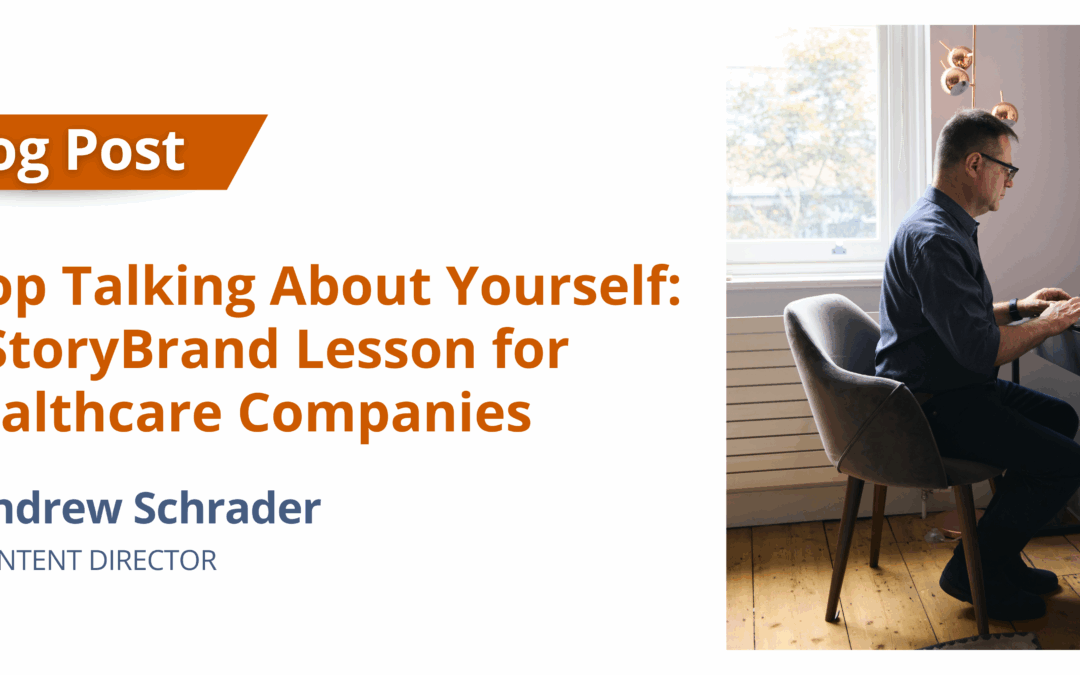
by Andrew Schrader | Oct 1, 2025 | Blog
For over ten years I’ve helped healthcare, health tech, and life sciences companies clarify their messaging and get their customers to listen. And time after time, I’ve seen the same thing happen.
Companies fall in love with their own features and benefits.
It’s understandable — they’ve worked hard to build them. But here’s the problem: features and benefits aren’t a story. They don’t create stakes. And without stakes, no one cares.
The “Hero” Mistake
Let’s take a fictional example. Meet Acme Revenue Solutions, a company in the revenue cycle management (RCM) space. Here’s how they might describe themselves:
“Acme Revenue Solutions helps hospitals streamline billing, reduce claim denials, and accelerate reimbursements. Our platform uses AI-driven automation to handle coding, compliance, and collections. With Acme, you can save time, lower costs, and maximize revenue.”
Not bad, right? In fact, it’s how many healthcare companies present themselves. It lists the features, highlights the benefits, and checks the right boxes.
The problem is, it’s also forgettable.
Why? Because Acme is playing the hero, talking about their own superpowers. Meanwhile, the customer — the hospital CFO, the director of revenue cycle, the VP of finance — is left as a spectator in their own story.
And here’s the thing: your customer is not looking for a hero.
Your customer is the hero. You are the guide.
When you forget that, they tune out.
Enter StoryBrand
Six years ago, I had the chance to attend a three-day StoryBrand workshop, and it completely changed the way I thought about messaging. If you haven’t heard of it, StoryBrand is a simple, seven-step storytelling framework developed by Donald Miller. It helps companies stop confusing their audience and start clarifying what they actually offer.
The framework boils down to this:
- A Character — your customer.
- Has a Problem — the thing that keeps them up at night.
- And Meets a Guide — that’s you.
- Who Gives Them a Plan — a simple, clear path forward.
- And Calls Them to Action — tell them what to do.
- That Ends in Success — paint the picture of the win.
- And Helps Them Avoid Failure — don’t skip the consequences.
In this framework, the customer is always the hero. You’re the guide.
The reason so much marketing feels flat is because it’s upside-down. Instead of putting the customer at the center of the story, companies hog the spotlight.
That’s why I like to bring in another concept — stakes. When you define what the customer stands to gain or lose, you put urgency and meaning back into the story. And that’s what makes StoryBrand so powerful.
Reframing With Stakes
So how do we make Acme’s message actually matter? We switch the lens. Instead of rattling off features and benefits, we frame the stakes — what the customer stands to gain or lose.
Here’s a rewrite, StoryBrand-style:
“Every day a claim is denied, hospitals lose critical revenue that should be funding patient care. Billing teams are overwhelmed, clinicians are frustrated, and patients get caught in the middle. It doesn’t have to be this way.
Acme Revenue Solutions gives your hospital the clarity and control to stop revenue leakage before it happens. With automated claim scrubbing, real-time alerts, and expert support, you can finally focus on care instead of paperwork. Hospitals should be thriving, not drowning in denials. We’ll help you get paid what you’ve earned — so you can put resources where they belong: in patient care.”
Notice the difference?
- External stakes: Denied claims, lost revenue, overworked staff.
- Internal stakes: The frustration of “drowning in denials” and the relief of “finally focusing on care.”
- Philosophical stakes: The belief that hospitals should be thriving and resources should support patient care.
Now, the customer is the hero. They’re the one solving the problem and reclaiming their story. Acme’s role? The guide who gives them the plan and the tools to succeed.
How Writers Make the Switch
When I write for clients, this is the mental shift I’m making. If I catch myself listing features, I stop and ask:
- What’s really at stake for the customer?
- What happens if they don’t solve this problem?
- How will they feel if they do?
- What’s the bigger “should” at play here?
That’s when the copy comes alive. That’s when it stops sounding like every other vendor in the healthcare space. And that’s when customers lean in — because they see themselves in the story.
One other thing: every company truly is unique. Most of the time, that uniqueness is baked into the reason the company exists in the first place — a founder who was fed up with the status quo, a team who saw a better way, or a conviction that something in healthcare just shouldn’t be this hard.
The trouble is, those origin stories often get buried under layers of jargon. My job as a writer is to dig them out and bring them forward. Because yes, two companies might sound alike on the surface — but they aren’t alike. And those distinctions are part of the stakes. They show what’s broken in the world, and why the company exists to fix it.
That’s where the most compelling stories live.
The Bottom Line
If you want your marketing messaging to land, stop trying to be Luke Skywalker. Be Yoda. Be Obi-Wan. Help your customer win their fight.
Because at the end of the day, they don’t want to hear about your features. They want to know what’s at stake — and how you’ll guide them to success.

by Administrator | Aug 4, 2025 | News
SCOTTSDALE, Ariz., Aug. 5, 2025 – Amendola, a nationally recognized, award-winning healthcare technology and life sciences public relations and marketing firm, announced ArcheHealth has selected Amendola to execute an integrated PR and marketing program to take the company from stealth to emerging market leader in healthcare operational intelligence.
ArcheHealth recently secured a $6.7 million round of seed funding to launch its platform, funded by LRVHealth, Martin Ventures, and Texas Health Resources. Amendola is providing a comprehensive PR and marketing program to showcase ArcheHealth’s transformative AI-powered technology and services, designed to deliver unique and granular insights into the true cost of healthcare, empowering healthcare organizations to identify and resolve inefficiencies that drive up costs and delay care.
“At ArcheHealth we are seeking to empower healthcare leaders with brilliant clarity about the true cost of care so they can achieve lasting, meaningful organizational benefits,” said Ralph Keiser, CEO and founder, ArcheHealth. “I previously worked with Jodi and the Amendola team at other organizations and I knew that no one could do a better job amplifying our value proposition in the market and help to drive our success.”
Agency president Jodi Amendola said: “If Ralph Keiser is at the helm, I am confident that ArcheHealth’s platform will deliver on its promise to advance operational intelligence to address critical inefficiencies to improve both clinical and financial outcomes for hospitals and health systems nationwide. We look forward to showcasing the innovation that ArcheHealth’s solution delivers to healthcare providers by sharing their success stories through PR, social media, and marketing programs.”
About ArcheHealth
ArcheHealth is transforming hospital operations by turning complexity into clarity. Our AI powered platform helps health systems identify and resolve inefficiencies that drive up costs and delay care. By capturing the true cost of care at the patient-event-item level, we illuminate the full economic picture of healthcare delivery. Powered by deep process analytics, AI, and real-time data integration across clinical, financial, operational, and supply chain systems, ArcheHealth delivers actionable insights that enable margin improvement, empowered teams, and better outcomes for patients and providers. To learn more, visit archehealth.ai and follow ArcheHealth on LinkedIn.
About Amendola
Amendola, part of Supreme Group, is an award-winning, insights-driven public relations and marketing firm that integrates media relations, social media, content, and lead gen programs to move healthcare, life sciences/pharma and healthcare IT decision-makers to action. The agency represents some of the industry’s best-known brands as well as groundbreaking startups that are disrupting the status quo. Nearly 90% of its client base represents multi-year clients and/or repeat client executives. Amendola’s seasoned team of PR and marketing pros understand the ongoing complexities of the healthcare ecosystem and provide strategic guidance and creative direction to drive positive ROI, boost reputation and increase market share. Making an impact since 2003, Amendola combines traditional and digital media to fuel meaningful and measurable growth. For more information about the industry’s “A-Team,” visit our website and follow us on LinkedIn.
# # #
Media Contact: Marcia G. Rhodes, Amendola Communications, mrhodes@acmarketingpr.com

by Chris Nerney | May 28, 2025 | Blog
Some health technology entrepreneurs are absolutely convinced their company has a unique, revolutionary solution that will transform healthcare. And they will not hesitate to tell you!
Most, however, are more grounded. They only have to look around to see that the problems their solution is designed to solve – whether it’s clinical data quality, patient identity, billing accuracy, etc. – have attracted the interest of other clever and well-intentioned people. They have competition! Worse, some of these sector rivals are well-funded.
Which doesn’t mean your solution is any less genuinely transformative to healthcare consumers, providers, payers, or researchers. What it does mean is you likely face a formidable challenge in rising above the noise in your sector to attract and capture the attention of potential customers and investors. After all, there are a lot of stories being told out there.
So how can healthcare PR and marketing pros make their company’s story compelling enough to break through and stand out in a crowded market? For starters, health tech companies can gain a market advantage by clearly articulating (and repeating) across multiple channels what problems their solutions solve and how these solutions benefit patients. Why should customers choose your solution and not a competitor’s? You need a great answer to that question.
Hone your marketing language to highlight your company’s competitive differentiators. Once you’ve locked in on a framework for your messaging, you can deploy several specific techniques to help your health tech company rise above the clamoring masses. These include:
Practice precision marketing
The marketing messages that resonate with potential customers such as provider organizations or payers may not resonate with investors. While a hospital or health plan will want to know what your technology costs and how it would help them improve care quality or operational efficiency, they’re not interested in a graphic showing the projected growth of your startup’s market sector. Investors, on the other hand, care deeply about a sector’s growth potential as well as a prospective portfolio company’s strengths and weaknesses (particularly its technology and leadership team) relative to the competition.
It is essential that you learn the needs and pain points of each target audience and then tailor a message that specifically addresses them. Try to get feedback from members of your target audience (or people who understand their concerns and priorities) and then modify as necessary.
Go multimedia
We may be in the technology business, but humanity sells. The human connection is a powerful thing; people like to hear and see other people talk. That’s one of the reasons why podcasts have become so popular. If there is someone in your company who could shine on a podcast, do not hesitate to get that person some training and some bookings.
No matter how nervous your subject matter expert may be, once they see the positive response internally and externally, they’ll be pestering you for more podcast opportunities. Then they’ll ask for help getting an agent.
You also can use multimedia in social media and in press releases. Spice up your messaging with pictures, graphics, and even short videos. You won’t need to hire a crew for a three-camera shoot, either; videos can easily be recorded on a smartphone.
Get customers to tell their story
I know, it’s one of the hardest things in marketing. A health tech company’s customers – whether they’re a hospital, health system, payer, or academic center – may not want to get involved in your marketing efforts because 1) they’re pretty busy doing their own jobs, and 2) they worry about being perceived as shills for a vendor. From their perspective, those aren’t unreasonable concerns.
But you won’t know what your customers say until you ask. Suggest doing a white paper on their experiences with your solution or ask for one of their spokespeople to join you on stage at an industry conference or for a podcast. People like to talk about their successes and impart advice to colleagues. It’s all upside to them.
One great selling point for healthcare marketing and PR pros who are trying to get a customer to share their experiences is to emphasize that the customer’s story (and yours) centers around how they were able to better serve patients using your technology, not the merits of the technology itself (which should be apparent in the telling of the story). Again, it’s an opportunity for the customer to talk about what they’re doing to help patients, research, or efforts to control healthcare costs.
Conclusion
To succeed in highly competitive markets, health tech vendors need a coherent message centered around how their solution benefits both patients and potential customers. By tailoring these messages to targeted audiences, leveraging the power of multimedia to build human connections, and working with customers to communicate powerful success stories, health tech vendors truly can stand out in a crowded market.

by Morgan Lewis | Mar 5, 2025 | Blog
Now that we’re well into 2025, I thought it would be interesting to look back at the most-read blog posts of 2024. My theory about these popular posts is that they reflect the concerns, curiosities and goals of the larger population of that time … or it could just be our team’s savvy SEO strategies and engaging writing skills that kept readers reading.
Regardless, last year’s most-read posts indicate that visitors were looking for levity, given the many popular articles’ lighthearted nature. This is also understandable, considering that many of us were looking for some relief in 2024 from the nonstop barrage of news about the U.S. Presidential campaign.
Another theme that emerged is that several of you – despite the growth of ChatGPT and other generative AI writing tools – seemed to be looking for writing tips and commentary to improve your content. Hooray for real-life human writers!
Without further ado, the following are the top 5 most-read Amendola blog posts from 2024 (in chronological order).
Top 5 Most-Read Blogs of 2024
- “The Taco Bell Times And The Depends Undergarments Press: Is This The Future Of Local News?” by Brandon Glenn.
This amusing post kicked off the year by first discussing an unfunny trend: the widespread closures of daily newspapers and layoffs of journalists. This topic is close to our hearts at Amendola, given that many of us came from consumer and business journalism before jumping to PR. The post, however, does steer toward levity as Brandon explores what could happen if mega-corporations step in to “save” local newspapers by purchasing naming rights or other such business ventures (which occurred at his hometown’s newspaper). What could go wrong?
- “The Best Rule in AP Style is About Animals with Names” by Brandon Glenn.
Brandon returns to the most-read blogs list with his hilarious take on an obscure Associated Press-style rule about pronouns for animals with and without given names. As a follower of AP style (the most common writing manual in consumer and business journalism) for over 25 years, I cannot remember ever looking up if I should refer to a dog named Rex as “who” or “that” in a sentence. Thankfully, the style guide editors resolved this dilemma, which Brandon whimsically explains. So, which is it? You’ll have to read the post to find out.
- “Reflecting Back, Looking Forward: Amendola Marks 20th Anniversary,” by Jodi Amendola.
Our founder and CEO, Jodi Amendola, has seen it all in health tech: digital transformation, the rise of virtual care, COVID-19, and now, generative AI. Jodi’s vast experience and success are likely why so many blog visitors read her post on the 20th anniversary of the agency she launched out of her parents’ condo in Scottsdale, Arizona. Her secret? Jodi humbly admits that she doesn’t have a crystal ball to foretell the industry’s tumultuous changes. Instead, preparing for the unexpected, staying nimble and building the right team have made all the difference over the last two decades.
- “When Slow is the Way To Go in PR and Marketing,” by Chris Nerney.
Post-author and Senior Content Director Chris has decades of experience in journalism, PR, and marketing content, as well as five years as a standup comic in Boston. His wit shows through in this post about the occasions where speed is more of a risk than a benefit. Although filled with valuable and actionable information, Chris injects plenty of humor in describing situations professionals in our industry will recognize. For example: “…you may be writing about concepts that may be ever-so-slightly outside your wheelhouse. That’s OK – you probably didn’t go to medical school, and your yearslong devotion to Grey’s Anatomy will only get you so far.”
- “The ABCs and the 3 Ps of Media Interviews,” by Grace Vinton.
Our media relations dynamo and health-tech celebrity, Grace Vinton, offers advice on a perennial challenge facing health-tech PR and marketing professionals: media interviews. Grace, who has a hugely popular podcast of her own, presents helpful mnemonic devices in the post for health tech executives to prepare for interviews and tips for crafting memorable and easy-to-understand messages. Her guidance is also relevant for any chat with a potential customer, investor or partner where you may not have the time for a detailed discussion about your company and solutions.
New Year, Fresh Insight
Whether it’s writing tips, messaging advice, or insight into the health tech PR and marketing strategies, you can continue to rely on this blog in 2025 to supply you with relevant guidance. I can’t promise that all the posts will be humorous, but they will surely be engaging and informative. Thanks for reading!

by Administrator | Jan 28, 2025 | News
SCOTTSDALE, Ariz., Jan. 28, 2025 – Amendola Communications (Amendola), part of Supreme Group, announced today that it has been selected by Life365 Health, a leading developer of virtual care technology solutions that enable healthcare delivery at home, to implement a national PR/marketing program.
“Life365 Health chose Amendola to help drive awareness and interest in our AI-driven platform, because of its deep understanding of healthcare, strong media relationships, senior level team and expert writers,” said Kent Dicks, CEO and founder. “Our technology goes beyond remote patient monitoring (RPM) to help healthcare organizations manage large patient populations in a proactive, pre-emptive, prioritized, and personalized manner. We look forward to collaborating with Amendola to more broadly share the story of how we help healthcare organizations monitor populations, improve patient engagement, and control costs.”
Amendola is implementing a comprehensive program of messaging, marketing, public relations, and social media to demonstrate Life365 Health’s industry-leading technology and services, accomplishments, customer wins, and industry partnerships, including those with Veterans Affairs and Microsoft.
Life365 Health has continually set the standard for innovation in RPM and virtual care solutions. The company’s mission is to enable new models of care where technologies, like AI and machine learning, play a crucial role in connecting with a large population of patients to receive insights from home to prioritize those who may be headed to more costly locations.
“Far too often, the RPM process engages with patients far too late, after patients have been discharged from the hospital in a reactive and expensive manner,” said Jodi Amendola, agency CEO. “Life365 is changing this outdated and ineffective model by advancing healthcare delivery with leading-edge technology that enhances patient engagement, personalized care, and facilitates proactive interventions to improve outcomes. We are delighted to help this leader in at-home virtual care expand its customer base and market presence.”
About Life365
Life365 Health is a leading developer of virtual care technology solutions that enable healthcare delivery at home. The Life365 platform addresses key care delivery challenges by providing scalable solution integration and logistics to enterprise healthcare organizations, to enable patient connectivity, engagement, and improved outcomes for their patient populations at home. The platform provides a single integration point that enables providers, payers, and others to utilize a proactive, virtual first care approach to remotely engage and monitor patients with a variety of conditions and needs. These include chronic disease management, post-discharge care, and population health management.
Life365 is led by an experienced, industry recognized team and is a major patent holder of wearables, sensors and patches driven by machine learning / AI, to drive the next generation of remote patient monitoring to scale. Life365 is a strategic partner of Microsoft Cloud for Healthcare and the Veterans Association, serving the largest population of Veterans in the world.
For more information regarding Life365, please visit www.life365.health.
About Amendola
Amendola, part of Supreme Group, is an award-winning, insights-driven public relations and marketing firm that integrates media relations, social media, content, and lead gen programs to move healthcare, life sciences/pharma and healthcare IT decision-makers to action. The agency represents some of the industry’s best-known brands as well as groundbreaking startups disrupting the status quo. Nearly 90% of its client base represents multi-year clients and/or repeat client executives. Amendola’s seasoned team of PR and marketing pros understand the ongoing complexities of the healthcare ecosystem and provide strategic guidance and creative direction to drive positive ROI, boost reputation and increase market share. Making an impact since 2003, Amendola combines traditional and digital media to fuel meaningful and measurable growth. For more information about the industry’s “A-Team,” visit our website and follow us on LinkedIn.
Media Contact
Philip Anast
Amendola for Life365 Health
panast@acmarketingpr.com
Page 1 of 812345...»Last »




